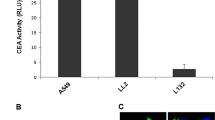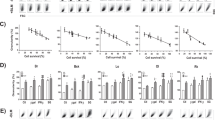Abstract
Suicide gene therapy of malignant melanoma essentially requires efficient gene transfer and highly selective therapeutic gene expression. To achieve this, recombinant adeno-associated virus (rAAV) particles were constructed containing the tissue-specific promoter of the human melanoma inhibitory activity (hMIA) gene combined with four copies of the enhancer element of the murine tyrosinase gene. Three melanoma and one cervix carcinoma cell line were infected with rAAV particles carrying a reporter gene under control of the enhancer/hMIA promoter in order to determine transcriptional activity and specificity of this system. Viral particles containing the enhancer/hMIA promoter mediated reporter gene activity only in melanoma cells, whereas infection with a cytomegalovirus (CMV)-based promoter construct induced unspecific gene expression. Correspondingly, transient transduction with viral particles bearing the HSVtk gene under the control of the enhancer/MIA promoter elements followed by treatment with ganciclovir (GCV) resulted in growth inhibition only in melanoma cells, whereas the CMV promoter-based construct induced unspecific cytotoxicity. In vivo experiments in nude mice demonstrated that tumors originating from human melanoma cells disappeared after stable, but not transient transduction with vectors bearing the HSVtk gene under the control of the enhancer/hMIA promoter in response to GCV application. In face of higher transduction efficiency, these rAAV particles might therefore be a useful tool for suicide gene therapy of malignant melanoma.
This is a preview of subscription content, access via your institution
Access options
Subscribe to this journal
Receive 12 print issues and online access
$259.00 per year
only $21.58 per issue
Buy this article
- Purchase on Springer Link
- Instant access to full article PDF
Prices may be subject to local taxes which are calculated during checkout






Similar content being viewed by others
References
Koh HK . Cutaneous melanoma. N Engl J Med. 1991;325:171–182.
Glass AG, Hoover RN . The emerging epidemic of melanoma and squamous cell skin cancer. JAMA. 1989;262:2097–2100.
Rigel DS, Kopf AW, Friedman RJ . The rate of malignant melanoma in the United States: are we making an impact? J Am Acad Dermatol. 1987;17:1050–1053.
Young RC . Cancer statistics, 2002: progress or cause for concern? CA Cancer J Clin. 2002;52:6–7.
McMasters KM, Sondak VK, Lotze MT, Ross MI . Recent advances in melanoma staging and therapy. Ann Surg Oncol. 1999;6:467–475.
Ezzeddine ZD, Martuza RL, Platika D, et al. Selective killing of glioma cells in culture and in vivo by retrovirus transfer of the herpes simplex virus thymidine kinase gene. N Biol. 1991;3:608–614.
Heyman RA, Borrelli E, Lesley J, et al. Thymidine kinase obliteration: creation of transgenic mice with controlled immune deficiency. Proc Natl Acad Sci USA. 1989;86:2698–2702.
Takamiya Y, Short MP, Ezzeddine ZD, Moolten FL, Breakefield XO, Martuza RL . Gene therapy of malignant brain tumors: a rat glioma line bearing the herpes simplex virus type 1-thymidine kinase gene and wild type retrovirus kills other tumor cells. J Neurosci Res. 1992;33:493–503.
Berns KI, Bohenzky RA . Adeno-associated viruses: an update. Adv Virus Res. 1987;32:243–306.
Conrad CK, Allen SS, Afione SA, et al. Safety of single-dose administration of an adeno-associated virus (AAV)-CFTR vector in the primate lung. Gene Therapy. 1996;3:658–668.
Kessler PD, Podsakoff GM, Chen X, et al. Gene delivery to skeletal muscle results in sustained expression and systemic delivery of a therapeutic protein. Proc Natl Acad Sci USA. 1996;93:14082–14087.
Fisher KJ, Jooss K, Alston J, et al. Recombinant adeno-associated virus for muscle directed gene therapy. Nat Med. 1997;3:306–312.
Herzog RW, Hagstrom JN, Kung SH, et al. Stable gene transfer and expression of human blood coagulation factor IX after intramuscular injection of recombinant adeno-associated virus. Proc Natl Acad Sci USA. 1997;94:5804–5809.
Kaplitt MG, Leone P, Samulski RJ, et al. Long-term gene expression and phenotypic correction using adeno-associated virus vectors in the mammalian brain. Nat Genet. 1994;8:148–154.
Podsakoff G, Wong Jr KK, Chatterjee S . Efficient gene transfer into nondividing cells by adeno-associated virus-based vectors. J Virol. 1994;68:5656–5666.
Russell DW, Miller AD, Alexander IE . Adeno-associated virus vectors preferentially transduce cells in S phase. Proc Natl Acad Sci USA. 1994;91:8915–8919.
Alexander IE, Russell DW, Spence AM, Miller AD . Effects of gamma irradiation on the transduction of dividing and nondividing cells in brain and muscle of rats by adeno-associated virus vectors. Hum Gene Ther. 1996;7:841–850.
Cheung AK, Hoggan MD, Hauswirth WW, Berns KI . Integration of the adeno-associated virus genome into cellular DNA in latently infected human Detroit 6 cells. J Virol. 1980;33:739–748.
Laughlin CA, Cardellichio CB, Coon HC . Latent infection of KB cells with adeno-associated virus type 2. J Virol. 1986;60:515–524.
Vile RG, Hart IR . Use of tissue-specific expression of the herpes simplex virus thymidine kinase gene to inhibit growth of established murine melanomas following direct intratumoral injection of DNA. Cancer Res.. 1993;53:3860–3864.
Vile R, Miller N, Chernajovsky Y, Hart I . A comparison of the properties of different retroviral vectors containing the murine tyrosinase promoter to achieve transcriptionally targeted expression of the HSVtk or IL-2 genes. Gene Therapy. 1994;1:307–316.
Vile RG, Hart IR . In vitro and in vivo targeting of gene expression to melanoma cells. Cancer Res. 1993;53:962–967.
Vile RG, Hart IR . Targeting of cytokine gene expression to malignant melanoma cells using tissue specific promoter sequences. Ann Oncol. 1994;5 (Suppl 4):59–65.
Hart IR, Vile RG . Targeted therapy for malignant melanoma. Curr Opin Oncol. 1994;6:221–225.
Hart IR, Vile RG . Targeted gene therapy. Br Med Bull. 1995;51:647–655.
Stoll R, Renner C, Zweckstetter M, et al. The extracellular human melanoma inhibitory activity (MIA) protein adopts an SH3 domain-like fold. EMBO J. 2001;20:340–349.
Bosserhoff AK, Echtenacher B, Hein R, Buettner R . Functional role of melanoma inhibitory activity in regulating invasion and metastasis of malignant melanoma cells in vivo. Melanoma Res. 2001;11:417–421.
Bosserhoff AK, Kaufmann M, Kaluza B, et al. Melanoma-inhibiting activity, a novel serum marker for progression of malignant melanoma. Cancer Res. 1997;57:3149–3153.
Stahlecker J, Gauger A, Bosserhoff A, Buttner R, Ring J, Hein R . MIA as a reliable tumor marker in the serum of patients with malignant melanoma. Anticancer Res. 2000;20:5041–5044.
Bosserhoff AK, Hein R, Bogdahn U, Buettner R . Structure and promoter analysis of the gene encoding the human melanoma-inhibiting protein MIA. J Biol Chem. 1996;271:490–495.
Bosserhoff AK, Kondo S, Moser M, et al. Mouse CD-RAP/MIA gene: structure, chromosomal localization, and expression in cartilage and chondrosarcoma. Dev Dyn. 1997;208:516–525.
Bosserhoff AK, Moser M, Hein R, Landthaler M, Buettner R . In situ expression patterns of melanoma-inhibiting activity (MIA) in melanomas and breast cancers. J Pathol. 1999;187:446–454.
Zolotukhin S, Potter M, Hauswirth WW, Guy J, Muzyczka N . A “humanized” green fluorescent protein cDNA adapted for high-level expression in mammalian cells. J Virol. 1996;70:4646–4654.
Rothfels H, Paschen A, Schadendorf D . Evaluation of combined gene regulatory elements for transcriptional targeting of suicide gene expression to malignant melanoma. Exp Dermatol. 2003;12:799–810.
Ganss R, Montoliu L, Monaghan AP, Schutz G . A cell-specific enhancer far upstream of the mouse tyrosinase gene confers high level and copy number-related expression in transgenic mice. EMBO J. 1994;13:3083–3093.
Grimm D, Kern A, Rittner K, Kleinschmidt JA . Novel tools for production and purification of recombinant adenoassociated virus vectors. Hum Gene Ther. 1998;9:2745–2760.
Haberkorn U, Khazaie K, Morr I, Altmann A, Muller M, van Kaick G . Ganciclovir uptake in human mammary carcinoma cells expressing herpes simplex virus thymidine kinase. Nucl Med Biol. 1998;25:367–373.
Huber BE, Richards CA, Krenitsky TA . Retroviral-mediated gene therapy for the treatment of hepatocellular carcinoma: an innovative approach for cancer therapy. Proc Natl Acad Sci USA. 1991;88:8039–8043.
Harris JD, Gutierrez AA, Hurst HC, Sikora K, Lemoine NR . Gene therapy for cancer using tumour-specific prodrug activation. Gene Therapy. 1994;1:170–175.
Smith MJ, Rousculp MD, Goldsmith KT, Curiel DT, Garver Jr RI . Surfactant protein A-directed toxin gene kills lung cancer cells in vitro. Hum Gene Ther. 1994;5:29–35.
Jiang S, Altmann A, Grimm D, et al. Tissue-specific gene expression in medullary thyroid carcinoma cells employing calcitonin regulatory elements and AAV vectors. Cancer Gene Ther. 2001;8:469–472.
Pang S, Taneja S, Dardashti K, et al. Prostate tissue specificity of the prostate-specific antigen promoter isolated from a patient with prostate cancer. Hum Gene Ther. 1995;6:1417–1426.
Miyao Y, Shimizu K, Moriuchi S, et al. Selective expression of foreign genes in glioma cells: use of the mouse myelin basic protein gene promoter to direct toxic gene expression. J Neurosci Res. 1993;36:472–479.
Ko SC, Cheon J, Kao C, et al. Osteocalcin promoter-based toxic gene therapy for the treatment of osteosarcoma in experimental models. Cancer Res. 1996;56:4614–4619.
Dietz UH, Sandell LJ . Cloning of a retinoic acid-sensitive mRNA expressed in cartilage and during chondrogenesis. J Biol Chem. 1996;271:3311–3316.
Hearing VJ, Tsukamoto K . Enzymatic control of pigmentation in mammals. FASEB J. 1991;5:2902–2909.
Deichmann M, Benner A, Bock M, et al. S100-Beta, melanoma-inhibiting activity, and lactate dehydrogenase discriminate progressive from nonprogressive American Joint Committee on Cancer stage IV melanoma. J Clin Oncol. 1999;17:1891–1896.
Ido A, Uto H, Moriuchi A, et al. Gene therapy targeting for hepatocellular carcinoma: selective and enhanced suicide gene expression regulated by a hypoxia-inducible enhancer linked to a human alpha-fetoprotein promoter. Cancer Res. 2001;61:3016–3021.
Modlich U, Pugh CW, Bicknell R . Increasing endothelial cell specific expression by the use of heterologous hypoxic and cytokine-inducible enhancers. Gene Therapy. 2000;7:896–902.
Engelmann C, Panis Y, Bolard J, et al. Liposomal encapsulation of ganciclovir enhances the efficacy of herpes simplex virus type 1 thymidine kinase suicide gene therapy against hepatic tumors in rats. Hum Gene Ther. 1999;10:1545–1551.
Caruso M, Panis Y, Gagandeep S, Houssin D, Salzmann JL, Klatzmann D . Regression of established macroscopic liver metastases after in situ transduction of a suicide gene. Proc Natl Acad Sci USA. 1993;90:7024–7028.
Haberkorn U, Bellemann ME, Gerlach L, et al. Uncoupling of 2-fluoro-2-deoxyglucose transport and phosphorylation in rat hepatoma during gene therapy with HSV thymidine kinase. Gene Therapy. 1998;5:880–887.
Klatzmann D, Cherin P, Bensimon G, et al. A phase I/II dose-escalation study of herpes simplex virus type 1 thymidine kinase “suicide” gene therapy for metastatic melanoma. Study Group on Gene Therapy of Metastatic Melanoma. Hum Gene Ther. 1998;9:2585–2594.
Author information
Authors and Affiliations
Corresponding author
Rights and permissions
About this article
Cite this article
Schoensiegel, F., Paschen, A., Sieger, S. et al. MIA (melanoma inhibitory activity) promoter mediated tissue-specific suicide gene therapy of malignant melanoma. Cancer Gene Ther 11, 408–418 (2004). https://doi.org/10.1038/sj.cgt.7700721
Received:
Published:
Issue Date:
DOI: https://doi.org/10.1038/sj.cgt.7700721
Keywords
This article is cited by
-
Prodrug converting enzyme gene delivery by L. monocytogenes
BMC Cancer (2008)
-
Carboxypeptidase G2-based gene-directed enzyme–prodrug therapy: a new weapon in the GDEPT armoury
Nature Reviews Cancer (2007)
-
Treatment of human disease by adeno-associated viral gene transfer
Human Genetics (2006)



